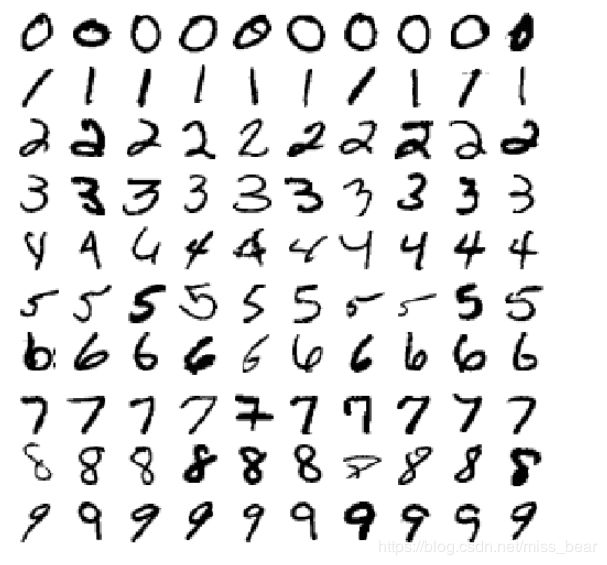人工智能与机器学习-分类器
机器学习基础第三章-分类器
一、查准率?查全率?
查准率(Precision)(精度)是衡量某一检索系统的信号噪声比的一种指标,即检出的相关文献与检出的全部文献的百分比。普遍表示为:查准率=(检索出的相关信息量/检索出的信息总量)x100%。
查全率(召回率),是衡量某一检索系统从文献集合中检出相关文献成功度的一项指标,即检出的相关文献与全部相关文献的百分比。普遍表示为:查全率=(检索出的相关信息量/系统中的相关信息总量)x100%。百度百科
对于二分类问题,可将样例根据其真实类别与学习器预测类别的组合划分为真正例(true positive),假正例(false positive),真反例(true negative),假反例(false negative)四种情形,令TP、FP、TN、FN分别表示其对应的样例数,则显然有TP+FP+TN+FN=样例总数。分类结果的“混淆矩阵”如下表所示

查准率P与查全率R分别定义为
P=TP/TP+FP
R=TP/TP+FN
查准率和查全率是一对矛盾的度量。一般来说,查准率高时,查全率往往偏低;而查全率高时,查准率往往偏低!
二、ROC、混淆矩阵、F1-Score
1、一种经常与二元分类器一起使用的工具,叫做受试者工作特征曲线(简称ROC)。它与精度/召回率曲线非常相似,但绘制的不是精度和召回率,而是真正类率(召回率的另一种称呼)和假正类率(FPR)。FPR是被错误分为正类的负类实例比率。它等于1-真负类率(TNR),后者正是被正确分类为负类的负类实例比率,也称为奇异度。因此ROC曲线绘制的是灵敏度和(1-奇异度)的关系。


2、混淆矩阵也称误差矩阵,是表示精度评价的一种标准格式,用n行n列的矩阵形式来表示。具体评价指标有总体精度、制图精度、用户精度等,这些精度指标从不同的侧面反映了图像分类的精度。 [1] 在人工智能中,混淆矩阵(confusion matrix)是可视化工具,特别用于监督学习,在无监督学习一般叫做匹配矩阵。在图像精度评价中,主要用于比较分类结果和实际测得值,可以把分类结果的精度显示在一个混淆矩阵里面。混淆矩阵是通过将每个实测像元的位置和分类与分类图像中的相应位置和分类相比较计算的。
3、F1 Score,是统计学中用来衡量二分类模型精确度的一种指标。它同时兼顾了分类模型的精确率和召回率。F1分数可以看作是模型精确率和召回率的一种调和平均,它的最大值是1,最小值是0。
三、展示手写体Mnist数据集中10个字符 (0-9)
数据介绍:本章使用MNIST数据集,这是一组由美国高中生和人口调查局员工手写的70000个数字的图片。每张图像都用其代表的数字标记。这个数据集被广为使用,因此也被称作是机器学习领域的“Hello World”:但凡有人想到了一个新的分类算法,都会想看看在MNIST上的执行结果。因此只要是学习机器学习的人,早晚都要面对MNIST。
from sklearn.datasets import fetch_openml
import numpy as np
import os
# to make this notebook's output stable across runs
np.random.seed(42)
# To plot pretty figures
%matplotlib inline
import matplotlib as mpl
import matplotlib.pyplot as plt
mpl.rc('axes', labelsize=14)
mpl.rc('xtick', labelsize=12)
mpl.rc('ytick', labelsize=12)
# 为了显示中文
mpl.rcParams['font.sans-serif'] = [u'SimHei']
mpl.rcParams['axes.unicode_minus'] = False
# 耗时巨大
def sort_by_target(mnist):
reorder_train=np.array(sorted([(target,i) for i, target in enumerate(mnist.target[:60000])]))[:,1]
reorder_test=np.array(sorted([(target,i) for i, target in enumerate(mnist.target[60000:])]))[:,1]
mnist.data[:60000]=mnist.data[reorder_train]
mnist.target[:60000]=mnist.target[reorder_train]
mnist.data[60000:]=mnist.data[reorder_test+60000]
mnist.target[60000:]=mnist.target[reorder_test+60000]
mnist=fetch_openml('mnist_784',version=1,cache=True)
mnist.target=mnist.target.astype(np.int8)
sort_by_target(mnist)
mnist["data"], mnist["target"]
#打印数据的维度
mnist.data.shape
X,y=mnist["data"],mnist["target"]
X.shape
y.shape
28*28
展示出手写体0
# 展示图片
def plot_digit(data):
image = data.reshape(28, 28)
plt.imshow(image, cmap = mpl.cm.binary,
interpolation="nearest")
plt.axis("off")
some_digit = X[00000]
plot_digit(X[00000].reshape(28,28))
# 展示图片
def plot_digit(data):
image = data.reshape(28, 28)
plt.imshow(image, cmap = mpl.cm.binary,
interpolation="nearest")
plt.axis("off")
some_digit = X[10000]
plot_digit(X[10000].reshape(28,28))
# 展示图片
def plot_digit(data):
image = data.reshape(28, 28)
plt.imshow(image, cmap = mpl.cm.binary,
interpolation="nearest")
plt.axis("off")
some_digit = X[14000]
plot_digit(X[14000].reshape(28,28))
展示出手写体3
# 展示图片
def plot_digit(data):
image = data.reshape(28, 28)
plt.imshow(image, cmap = mpl.cm.binary,
interpolation="nearest")
plt.axis("off")
some_digit = X[22000]
plot_digit(X[22000].reshape(28,28))
展示出手写体4
# 展示图片
def plot_digit(data):
image = data.reshape(28, 28)
plt.imshow(image, cmap = mpl.cm.binary,
interpolation="nearest")
plt.axis("off")
some_digit = X[26000]
plot_digit(X[26000].reshape(28,28))
展示出手写体5
# 展示图片
def plot_digit(data):
image = data.reshape(28, 28)
plt.imshow(image, cmap = mpl.cm.binary,
interpolation="nearest")
plt.axis("off")
some_digit = X[36000]
plot_digit(X[36000].reshape(28,28))
展示出手写体6
# 展示图片
def plot_digit(data):
image = data.reshape(28, 28)
plt.imshow(image, cmap = mpl.cm.binary,
interpolation="nearest")
plt.axis("off")
some_digit = X[40000]
plot_digit(X[40000].reshape(28,28))
展示出手写体7
# 展示图片
def plot_digit(data):
image = data.reshape(28, 28)
plt.imshow(image, cmap = mpl.cm.binary,
interpolation="nearest")
plt.axis("off")
some_digit = X[44000]
plot_digit(X[44000].reshape(28,28))
展示出手写体8
# 展示图片
def plot_digit(data):
image = data.reshape(28, 28)
plt.imshow(image, cmap = mpl.cm.binary,
interpolation="nearest")
plt.axis("off")
some_digit = X[52000]
plot_digit(X[52000].reshape(28,28))
展示出手写体9
# 展示图片
def plot_digit(data):
image = data.reshape(28, 28)
plt.imshow(image, cmap = mpl.cm.binary,
interpolation="nearest")
plt.axis("off")
some_digit = X[56000]
plot_digit(X[56000].reshape(28,28))
四、完成对手写体Mnist数据集中10个字符 (0-9)的分类识别
要运行下面的代码必须就要运行前面的那些代码(也就是展示手写体及其前面的代码)
y[36000]
# 更好看的图片展示
def plot_digits(instances,images_per_row=10,**options):
size=28
# 每一行有一个
image_pre_row=min(len(instances),images_per_row)
images=[instances.reshape(size,size) for instances in instances]
# 有几行
n_rows=(len(instances)-1) // image_pre_row+1
row_images=[]
n_empty=n_rows*image_pre_row-len(instances)
images.append(np.zeros((size,size*n_empty)))
for row in range(n_rows):
# 每一次添加一行
rimages=images[row*image_pre_row:(row+1)*image_pre_row]
# 对添加的每一行的额图片左右连接
row_images.append(np.concatenate(rimages,axis=1))
# 对添加的每一列图片 上下连接
image=np.concatenate(row_images,axis=0)
plt.imshow(image,cmap=mpl.cm.binary,**options)
plt.axis("off")
plt.figure(figsize=(9,9))
example_images=np.r_[X[:12000:600],X[13000:30600:600],X[30600:60000:590]]
plot_digits(example_images,images_per_row=10)
plt.show()
X_train, X_test, y_train, y_test = X[:60000], X[60000:], y[:60000], y[60000:]
同样,我们还需要对训练集进行洗牌,这样可以保证交叉验证的时候,所有的折叠都差不多。此外,有些机器学习算法对训练示例的循序敏感,如果连续输入许多相似的实例,可能导致执行的性能不佳。给数据洗牌,正是为了确保这种情况不会发生。
import numpy as np
shuffer_index=np.random.permutation(60000)
X_train,y_train=X_train[shuffer_index],y_train[shuffer_index]
训练一个二分类器
现在,我们先简化问题,只尝试识别一个数字,比如数字5,那么这个"数字5检测器",就是一个二分类器的例子,它只能区分两个类别:5和非5。先为此分类任务创建目录标量
y_train_5=(y_train==5)
y_test_5=(y_test==5)
接着挑选一个分类器并开始训练。一个好的选择是随机梯度下降(SGD)分类器,使用sklearn的SGDClassifier类即可。这个分类器的优势是:能够有效处理非常大型的数据集。这部分是因为SGD独立处理训练实例,一次一个(这也使得SGD非常适合在线学习任务)。
from sklearn.linear_model import SGDClassifier
sgd_clf=SGDClassifier(max_iter=5,tol=-np.infty,random_state=42)
sgd_clf.fit(X_train,y_train_5)
sgd_clf.predict([some_digit])
随机交叉验证和分层交叉验证效果对比
from sklearn.model_selection import cross_val_score
cross_val_score(sgd_clf, X_train, y_train_5, cv=3, scoring="accuracy")
# 类似于分层采样,每一折的分布类似
from sklearn.model_selection import StratifiedKFold
from sklearn.base import clone
skfolds = StratifiedKFold(n_splits=3, random_state=42)
for train_index, test_index in skfolds.split(X_train, y_train_5):
clone_clf = clone(sgd_clf)
X_train_folds = X_train[train_index]
y_train_folds = (y_train_5[train_index])
X_test_fold = X_train[test_index]
y_test_fold = (y_train_5[test_index])
clone_clf.fit(X_train_folds, y_train_folds)
y_pred = clone_clf.predict(X_test_fold)
n_correct = sum(y_pred == y_test_fold)
print(n_correct / len(y_pred))

我们可以看到两种交叉验证的准确率都达到了95%上下,看起来很神奇,不过在开始激动之前,让我们来看一个蠢笨的分类器,将所有图片都预测为‘非5’
from sklearn.base import BaseEstimator
# 随机预测模型
class Never5Classifier(BaseEstimator):
def fit(self, X, y=None):
pass
def predict(self, X):
return np.zeros((len(X), 1), dtype=bool)
never_5_clf = Never5Classifier()
cross_val_score(never_5_clf, X_train, y_train_5, cv=3, scoring="accuracy")
![]()
我们可以看到,准确率也超过了90%!这是因为我们只有大约10%的图像是数字5,所以只要猜一张图片不是5,那么有90%的时间都是正确的,简直超过了大预言家。这说明,准确率通常无法成为分类器的首要性能指标,特别是当我们处理偏斜数据集的时候(也就是某些类别比其他类更加频繁的时候)










